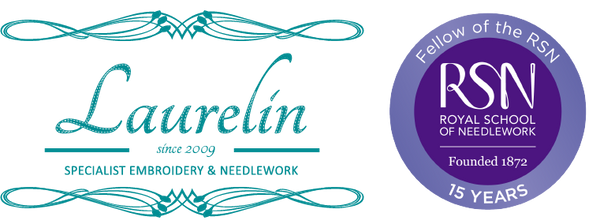Design Transfer - Painting
After you complete the 'prick and pounce' method, you can finish the transfer process with painting (you can also draw, if you like, but I'm focussing on painting as the traditional method).
Notes:
Colour: If you’re working mainly in one colour, like goldwork, you can match it to the stitching. If your stitching will be multi-coloured, match it to the fabric but make it a little lighter or darker.
Type of paint: acrylic, watercolour and oil paints all work for this process. Acrylic is easy to paint and gives a waterproof result, but is harder to clean up. Watercolour is slightly more prone to bleeding into the fabric and isn’t at all waterproof, but is easier to clean up and remove from brushes. You need watercolour in tubes, not blocks. Oil paint is the original waterproof paint and works very nicely, but it takes a very long time to dry and you need to use a paint thinner such as Liquin, rather than water, plus a solvent for cleaning up.
Brushes: use a larger or old brush for mixing – never mix with a tiny brush; it is ineffective and ruins the brush. Use a very small brush for painting: 000 or 0000 is a good place to start. A practiced painter could use a slightly larger brush and still achieve a very thin line, but it is much harder to do well.
Transcript:
Hello – Lizzy here. I’ve got some painting to do, so I’m going to show you how I do it. I’m going to be painting onto linen twill, so I’ve chosen a darker and brighter hue similar to the fabric – yellow ochre straight from the tube works really well, but you could use a little white to lighten it.
I start with a bit of paint in a palette or an old ramekin jar. Using an old brush, I pick up some water and begin to mix that into the paint. I want to mix it thoroughly so I don’t have watery or thick patches. I can keep adding water bit by bit until it reaches the consistency I want. I’m aiming for it to be thin enough to flow from the brush a little, but not so thin that it will bleed into the fabric. That looks a bit like this – just a bit thicker than double cream (for which apparently the nearest US equivalent is heavy cream).
I like to test the consistency on the corner of my fabric before I start. If it flows from the brush without bleeding, I’m happy. I also clean all my brushes at this point.
I’m using a tiny brush for the painting. I replace these brushes far more frequently than the larger sizes, because one hair out of place can cause a real issue. This is a triple zero brush, so it holds very little paint and is capable of making a very thin line.
You’ll notice that I’m holding the brush quite close to upright – almost 90 degrees to the fabric. I’ve loaded the brush with the tiniest bit of paint, by gently dipping the tip into the paint. I bring the brush down to touch the fabric and move my hand so that the tip of the brush remains in contact with the fabric, but without dragging it.
This is completely different to how you would typically use a brush in painting, where you would apply more pressure and drag or even roll the brush on the surface. Here, I am barely touching it to the fabric so it makes the thinnest possible line. That’s the key actually – I’m aiming for a clear, thin line. If the line is thick I might struggle to cover it with the stitches, and if it is broken and unclear I might struggle to follow it.
I’m keeping my hand hovering above the fabric as much as possible. Because you have pounce powder to consider as well as paint, it is a good idea to think how you will work around a larger design. I’m right handed and I usually start in the bottom right hand corner. I will then either turn the frame or have a few minutes rest before moving on, so that the paint is dry before I risk rubbing my hand on it.
Between every stroke, I’m cleaning my brush on a damp cloth. I pull it along the surface so that the hairs are kept together, but all the pounce powder is removed so it doesn’t clump. Every now and again I fully clean the brush by dipping it in water, and use the cloth to remove the excess water so I don’t dilute the paint.
In some places, the curve of the line allows me to make quite a long stretch in one go, because it feels comfortable. In others, I will make a series of very short lines. If you’re just starting out with painting, I recommend you make shorter strokes until you feel more comfortable – the longer the stroke, the more likely you are to wobble partway along.
Painting can take quite a while, especially if you’re new to it. Be mindful that the paint will start to dry as you work, so you might need to water it down again. Acrylic paint will dry soonest, and the dry paint will no longer take water; whereas watercolour can be watered down even from fully dry.
From here I just keep on painting. I really like to take my time, so I can paint as accurately as possible.
Thank you for watching. I hope you’ve found this helpful.
